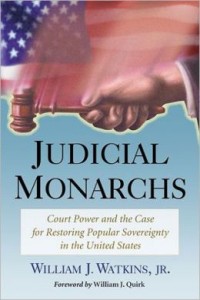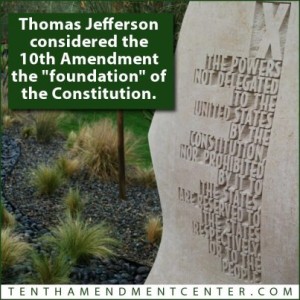Excerpted from an article which appeared in the Winter 1999 issue of The Independent Review
Working in complete secrecy, Jefferson drafted the Kentucky resolution of 1798 between 21 July and 26 October 1798. His original plan was for W. C. Nicholas to introduce the Resolves in North Carolina, but because of political setbacks there, Nicholas instead gave the Resolves to John Breckinridge for introduction in Kentucky. As an independent-minded frontier state, Kentucky was the perfect forum for Jefferson’s resolution. Across the state, without much prompting, citizens gathered to protest the Alien and Sedition Acts. In Lexington, five thousand people — a crowd three times the town’s population — assembled. On 7 November 1798, Governor James Gerrard announced the need for “a protest against all unconstitutional laws of Congress” (Koch and Ammon 1948, 156.) A committee led by John Breckinridge was appointed, and the Kentucky resolution was quickly introduced. On 10 November 1798 the Resolves, with modifications, passed the house with only three dissenting votes; three days later the Senate concurred.
The Resolves began with the Tenth Amendment, which Jefferson described in 1791 as “the foundation of the Constitution” (1943, 342). The states were not “united on the principles of unlimited submission to their General Government”; they had delegated only certain definite powers (Virginia Commission 1964, 143). Thus, “whensoever the General Government assumes undelegated powers, its acts are unauthoritative, void, and of no force” (143).
The resolution explicitly disclaimed that the national government was the judge of its own powers. Allowing it to judge its own powers would be akin to permitting an agent, rather than the principal, to determine the breadth of the agent’s authority. The law of agency at its most basic level recognizes that an agent can act as such only subject to the consent and control of the principal to whom the agent owes a fiduciary duty (see Restatement [Second] of Agency, sec. 1). Just as A, B, and C, the partners in a business firm, decide what authority to give their agent Z, so the parties to the Constitution decide the powers of the national government. In light of such logic, Jefferson proclaimed in the resolution that “each party [to the federal compact] has an equal right to judge for itself, as well of infractions as of the mode and measures of redress” (Virginia Commission 1964, 144). For Jefferson, the people acting through their states — the authentic organs of government — were the final arbiters of constitutional interpretation. Jefferson feared that giving the federal government the exclusive power to interpret the Constitution through the Supreme Court would lead to arbitrary government. As John Taylor later wrote in his Construction Construed and Constitutions Vindicated, “a jurisdiction, limited by its own will, is an unlimited jurisdiction” ([1820] 1970, 131). With the states stripped of the power to construe the Constitution, the enforcement of constitutional limitations on the central government would be chimerical. Thus, it is not surprising that none of the convictions under the Sedition Act were appealed to the Federalist-dominated Supreme Court. The Republicans did not want to give the Court an opportunity to set a dangerous precedent.
The resolution continued by spelling out why the Alien and Sedition Acts were unconstitutional. With respect to the Sedition Act, the second resolve reasoned that the states delegated to Congress the power to punish but a few specific crimes, such as treason, counterfeiting, and piracy. Thus, in light of the Tenth Amendment’s unmistakable declaration that what is not given is reserved, the Sedition Act failed constitutional examination.
The third resolve examined the Sedition Act in light of the First Amendment. Jefferson argued that because the First Amendment operated as a restraint only on the national government, the states “retain to themselves the right of judging how far the licentiousness of speech … may be abridged” (Virginia Commission 1964, 14). Though today it seems obvious that the Sedition Act was a violation of the First Amendment, in 1798 that understanding was not universal, and Jefferson’s argument was in the libertarian vanguard. As Leonard Levy has pointed out, the “Framers were nurtured on the crabbed historicism of Coke and the narrow conservatism of Blackstone” and thus probably did not intend to abolish the common law of seditious libel when adopting the First Amendment (1985, xv, 220-81). Original intent aside, Jefferson’s First Amendment arguments were instrumental in forming the libertarian view of freedom of speech.
The fourth, fifth, and sixth resolves dealt with the Alien Friends Act. Jefferson asserted that alien friends were under the jurisdiction of the laws of the state in which they resided. He pointed out that under the Constitution, Congress could not prohibit “the Migration or Importation of such Persons as any of the States now existing shall think proper to admit” until 1808 (Article 1, sec. 9). That reading of the Constitution’s slave-import clause demonstrates Jefferson’s inclination to read broadly the clauses limiting power. Conversely, Jefferson read the power-granting clauses narrowly.
Moreover, the act denied the aliens due process of law insofar as the president was judge, jury, and executioner. By investing the president with judicial power, the Alien Friends Act violated Article 3 of the Constitution. To Jefferson such a transgression of the separation of powers was but a sign of things to come. In the 1790s many Americans feared their republican experiment would end in a monarchy like the one from which they had seceded.
The seventh, eighth, and ninth resolves protested the construction of the necessary and proper clause that would give the general government unlimited power, and called upon the governor of Kentucky to transmit the Resolves to the legislatures of the several states. The ninth resolve expressed apprehension that continued usurpation by the national government could only “drive these states into revolution and blood, and will furnish new calumnies against Republican Governments, and new pretexts for those who wish it to be believed, that man cannot be governed but by a rod of iron” (Virginia Commission 1964, 149-50). The iron-rod statement exemplified Jefferson’s view, as expressed in his letter of 21 June 1823 to Justice William Johnson, that man is rational and need be restrained only “by moderate powers” exercised by officials chosen by their fellow citizens (1854b, 291). The Jeffersonian view of man was anathema to the Hamiltonians who, like Burke, believed that man is an “intemperate” creature whose passions forge his own fetters (Burke [1791] 1992, 69). To the Federalists, the Sedition Act exemplified a necessary restraint on man’s unruly passions.
The Kentucky resolution continued with the axiom that “free government is founded in jealousy and not in confidence,” because confidence “is every where the parent of despotism” (Virginia Commission 1964, 150). Therefore, when dealing “in questions of power then let no more be heard of confidence in man, but bind him down from mischief by the chains of the Constitution” (150). The resolution ended with a call to other states to express their opinions of the Alien and Sedition Acts. Though the resolution expressed confidence that “the co-States … will concur in declaring these acts void and of no force, and will each unite with this Commonwealth in requesting their repeal at the next session of Congress,” the response, to be discussed later, was not what the Republicans expected (151).
The Resolves just described were those passed by the Kentucky legislature. Several changes had been made to the original draft written by Jefferson and introduced by Breckinridge. One change was the omission of the term “nullification.” With Hamilton and others hoping for an opportunity to march on the so-called agents of Jacobinism, the use of Jefferson’s strong term might have given the hawks the opportunity they sought. In 1798 the Union was far closer to civil war than to a French invasion, and talk of “nullification” might have provided the spark to start a national conflagration.
As passed, the Kentucky resolution also omitted Jefferson’s call for a “committee of conference and correspondence” to foster communication among the states, which Hamilton had suggested in Federalist 28. As in the Cabell affair, Jefferson saw no reason to inform the Congress, inasmuch as Congress was not a party to the compact. The Kentucky legislature apparently preferred to work within the generally accepted constitutional framework and therefore shunned the creation of a committee of correspondence.
The most significant omission was Jefferson’s request that each of the co-states, as a party to the compact, “take measures of its own for providing that neither these acts, nor any others of the General Government not plainly and intentionally authorized by the Constitution, shall be exercised within their respective territories” (Jefferson 1943, 134). Such actions would have differed greatly from merely appealing to Congress for repeal of the acts; Jefferson expected the states to take active measures to thwart the execution of the Alien and Sedition Acts. And when he learned of the negative responses from the other states, he contemplated secession. Rather than relinquish liberties to a consolidated national government, Jefferson was prepared for Virginians and Kentuckians to “sever ourselves from that union we so much value, rather than give up the rights of self-government which we have reserved, & in which alone we see liberty, safety & happiness” (quoted in Koch and Ammon 1948, 166). Madison, who frequently served as a moderating influence on Jefferson, talked him out of moving toward secession, but the fact remains that the resolution as penned by Jefferson was meant to be more than a protest; Jefferson envisioned the states defying the unconstitutional acts of the national government (Banning 1995, 393).
 On 17 November 1798, Jefferson sent Madison a copy of his draft of the Kentucky resolution. Jefferson wrote that
On 17 November 1798, Jefferson sent Madison a copy of his draft of the Kentucky resolution. Jefferson wrote that
we should distinctly affirm all the important principles they contain, so as to hold to that ground in future, and leave the matter in such a train as that we may not be committed absolutely to push the matter to extremities, and yet may be free to push as far as events will render prudent. (Jefferson 1854a, 258)
That statement is noteworthy for several reasons. First, he was obviously pressing Madison to see that a similar resolution be passed in Virginia. Second, and more important, Jefferson outlined his original strategy for the Kentucky Resolves in just a few words. He did not want to be forced into a general confrontation with the national government over nullification, but intended to retain the option to push as far as events permitted. In light of the language in Jefferson’s original draft, had a number of states supported the resolution, it seems plausible that Jefferson might have begun drafting an ordinance of nullification for Kentucky.
Madison’s Virginia resolution, which was introduced in the Virginia Assembly by John Taylor, was much shorter and more moderate than Jefferson’s fervent Kentucky resolution. After expressing Virginia’s warm attachment to the Union, the resolution appealed to the Tenth Amendment and declared that the powers of the federal government are “limited by the plain sense and intention of the instrument constituting that compact” and
that in the case of a deliberate, palpable, and dangerous exercise of other powers, not granted by the said compact, the States … have the right, and are in duty bound, to interpose for arresting the progress of the evil, and for maintaining within their respective limits, the authorities, rights and liberties appertaining to them. (Virginia Commission 1964, 152)
William J. Watkins, Jr. is a Research Fellow at The Independent Institute and a legal scholar specializing in constitutional law and health law. He received his J.D. cum laude from the University of South Carolina School of Law and is a former law clerk to Judge William B. Traxler, Jr. of the U.S. Court of Appeals for the Fourth Circuit.

